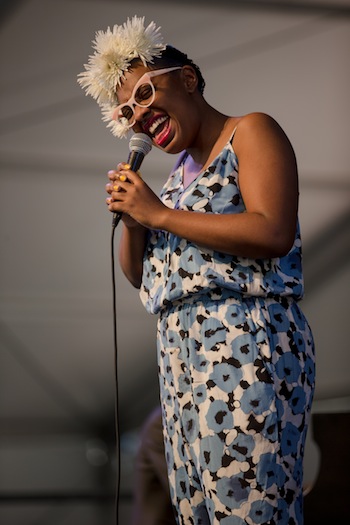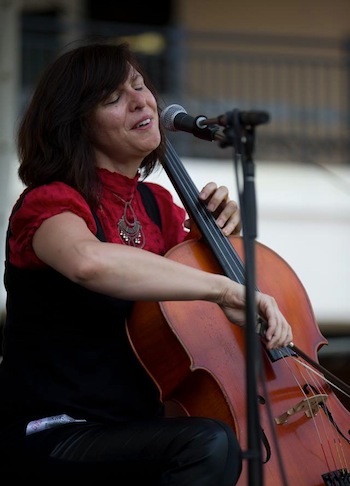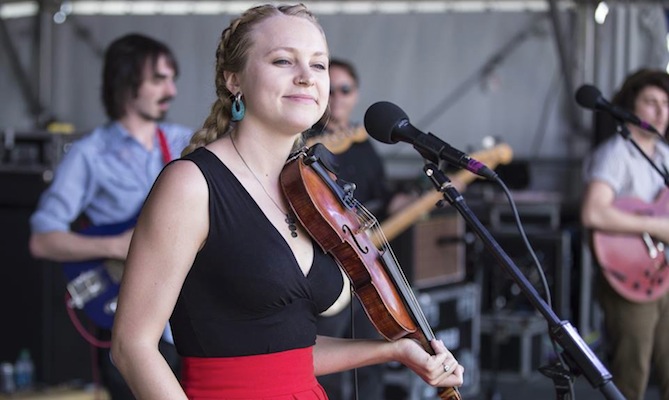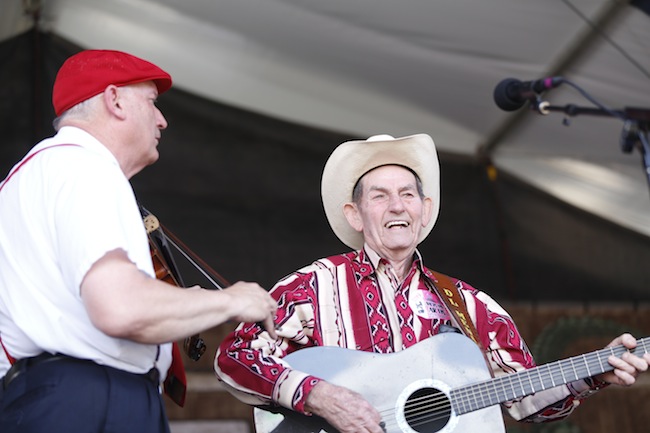Music Review: New Orleans Jazz & Heritage Festival 2015
The New Orleans JazzFest is made for omnivorous gluttons, which makes it a perfect complement to the region’s cuisine (which is also handsomely represented at the Fair Grounds).

Ironing Board Sam performing at this years’s New Orleans Jazz & Heritage Festival. Photo: Douglas Mason.
By Jon Garelick
The New Orleans Jazz & Heritage Festival (April 22 through May 1) isn’t a jazz festival, and it’s not entirely about New Orleans. For whatever it once was (the first festival featured Duke Ellington and Mahalia Jackson), the event is now an international music festival, drawing from all genres of pop and jazz. At the 46th annual festival, which closed on Sunday, that meant the Who, Elton John, Tony Bennett with Lady Gaga, Angelique Kidjo, T.I., and Steve Winwood along with New Orleans stalwarts like Dr. John, the Meters, the Radiators, Irma Thomas, John Boutté, Walter “Wolfman” Washington, and rising star Troy “Trombone Shorty” Andrews, among many others. Unlike most major festivals, JazzFest (as it’s affectionately known by longtime fans) is a polyglot musical stew – okay, if you must, gumbo. That means that in a short walk across the Fair Grounds Race Course – where the event is held – you can go from the enthralling artistry of Irma Thomas singing gospel to the ribald shaggy dog stories sung by Bobby Lounge.
There’s plenty of sniping about acts that don’t “belong” on the JazzFest schedule, not without some justification (for me, a low point was Phish a few years back). And there are also complaints that the pricing of the festival (which always takes place the last weekend in April and the first weekend in May) has become exclusive – something for well-to-do tourists. But you’d be hard pressed to find another festival that charges $70 for a day of music featuring 60 different acts, including those major headliners, who can easily get that ticket price for a solo show. That’s not counting the interview events, food and craft demonstrations (the “heritage,” as it was originally conceived by JazzFest founder George Wein), and special kids tent entertainment. The only thing that I can think of that comes close is the Montreal Jazz Festival, which offers hundreds of free performances, but with significant government funding. What’s more, as its critics sometimes forget, the JazzFest (presented by Shell) is owned by a non-profit foundation, which funnels money from the event back into the city’s music education programs, cultural events, and community development.

Cécile McLorin Salvant performing during the 2015 New Orleans Jazz & Heritage Festival. Photo: Douglas Mason.
My only serious complaint is that the Festival has never capped tickets sales, probably on the theory that the race track, with its 12 separate stages, can adequately disperse a crowd of just about any size. This year, during which I attended the second weekend, the festival drew 460,000 people over seven days, and on the second Saturday, there were multiple complaints of overcrowding on the two-football-field sized grounds of the Acura Stage, where Jerry Lee Lewis and Elton John were among the headliners. On that day, even the infield of the track was at times uncomfortably jammed. (The Festival does not release attendance figures for individual days.)
Okay, I know what you’re thinking: “But other than that, how was the show, Mrs. Lincoln?”
JazzFest is made for omnivorous gluttons, which makes it a perfect complement to the region’s cuisine (which is also handsomely represented at the Fair Grounds). You can hop from one genre-specific act or another, or you can find that special someone or something that contains multitudes. On the one hand, you’ve got genre-bending bands like Feufollet, a quintet that pushes the boundaries of Cajun fiddle-and-accordion dance music with edgy originals and covers that include Brian Eno’s “Baby’s on Fire.”
Or you could happen upon the brilliant cellist-singer-songwriter Helen Gillet. A Belgian-New Orleans transplant, Gillet in the last few years has made herself a ubiquitous presence on the local scene, playing with other singer-songwriters or in avant-garde jazz bands. But she is best appreciated solo. Using loops and a couple of microphones, Gillet lays down vamps – a bowed or plucked figure, a sung lyric, or a rhythm she slaps out on the body of her cello, layering the effects one line at a time and singing on top.

Cellist-singer-songwriter Helen Gillet performing during the 2015 New Orleans Jazz & Heritage Festival. Photo: Douglas Mason.
It sounds gimmicky (folk-pop singers Imogen Heap and Julia Easterlin are also known for their electronic one-woman-band performances), but it’s not. Gillet’s mix of material is constantly surprising (French chansons, Patsy Cline, X-Ray Spex, Sun Ra, Ornette Coleman) her songwriting is affecting, and her presentation is always measured and musical. Singing in a clear, vibratoless low soprano, she’ll spin an ambiguous tale about a lost child, or a suitor who gets cold feet, or someone “who falls in and out of love with an accordion player – as everyone does at one time or another.” Singing in French or English or Walloon, she can veer from desperate melancholy to ferocious ecstasy, dynamics shifting from sweet midrange cello line to rocking rhythmic propulsion. Performing at the fest’s Lagniappe stage Saturday, in the shelter of the track’s circular paddock, the loops swirling around her, she’d jump from her seat for a few moments of celebratory hopping dance. She addressed the crowd in fluent American-accented English, and on Monday night, when she played the outdoor courtyard Bywater restaurant Bacchanal, she advised a second-set audience member from the stage to buy her first CD, since it was the only one left on the merch table : “Trust me, I’m Belgian.”
Of course, there were also superlative examples of musicians who transcended genre through sheer mastery of its conventions. The Jambalaya Cajun Band, who first played the fest in 1989, were once again joined by special guest D.L. Menard, “the Cajun Hank Williams,” who was inspired to play music by meeting Hank Sr. in 1951. Now 82, spry and full-voiced, with a hawkish gleam in his eye, Menard sang his various hits, including “The Back Door,” and Hank’s “Your Cheatin’ Heart,” while dancers whipped up the dust in front of the Fais Do-Do stage. The band’s two-steps and waltzes were positively buoyant, and as Reggie Matte pumped his diatonic button accordion, it was as though the instrument were a small bellows, the rhythm of its doubled-notes inflating the pocket of air that lifted the dancers and set them down, one step after the next.
Mastery of another sort was on display in the Jazz Tent Friday, when the young star singer Cécile McLorin Salvant held forth. “I think she’s toying with us,” a friend of mine whispered to me as McLorin Salvant shifted from the 1936 tune “You Bring Out the Savage in Me” (by trumpeter, singer, and bandleader Valaida Snow) to the devastating Mad Men-era Nancy Wilson ballad, “Guess Who I Saw Today.” With her unforced, rounded alto, wickedly sly phrasing, sure dynamics, and careful etching of the lyrics, McLorin Salvant said more about race, gender, and romantic love in two songs than most singers say in a lifetime. She could indeed have wrapped the entire audience in a box and taken it home. For her finale of Leonard Bernstein and Stephen Sondheim’s “Something’s Coming,” from West Side Story, she brought the usually frantic tempo down to a simmer, and pianist Aaron Diehl fashioned his big solo not as a “jazz” solo, but as a spontaneous orchestral arrangement of the tune. Part of McLorin Salvant’s mastery of the audience comes from her knowing deployment of that voice, so big and secure that you always sense there’s plenty more left in the tank. On “Something’s Coming,” she reared back her head, and made a three-octave leap on the two syllables of the final word, “To-NIGHT!,” and brought down the house.

Kelli Jones-Savoy of Feufollet performing at this year’s New Orleans Jazz & Heritage Festival. Photo: Zach Smith.
There were other, simpler pleasures that weren’t all that simple when you thought about them. Like the O’Jays, with two of its three original members, Eddie Levert and Walter Williams, plus Eric Grant, resplendent in white suits (jackets open to bare chests, of course), making their coordinated dance moves in the blazing sunshine of the open-air Congo Square stage Sunday, singing “Back Stabbers” and “Love Train,” and getting the whole crowd to sing along to “For the Love of Money” (“mean green!”). Call it disco, call it R&B, it was beyond genre, and it was sublime.
On the other side of the world, at the Jazz and Heritage Stage, Fredy Omar Con Su Banda played a latter-perfect mix of merengue and Afro-Cuban salsa, montuno vamps driving trumpet arias, timbales beating the rhythm with a high metallic crack. Bobby Lounge, meanwhile, plied his irresistible shtick on the Lagniappe Stage, accompanied only by his own boogie-woogie piano – non-hits like “Take Me Back to Abita Springs” and “My Little Apalachicola Girl.” You could see the jokes coming from a mile away, but it didn’t matter. And when he sang, “I’ll Always Be Better Than You,” it was a joke, all right, but also, it seemed, a terse comment on the presidential campaign season and our currently fraught socio-political moment (“I will stand by you/as long as you stay in your place”).
I wouldn’t miss a show by Bobby Lounge any more than I’d miss at least one trip down Bourbon Street – the gaudy trash culture of New Orleans that’s the flip side of its enduring greatness, a culture that the Mississippi-born Bobby Lounge sends up and loves. Maybe that’s why I had so much trouble tearing myself away from Ironing Board Sam in the Blues Tent on Sunday.

Jambalaya Cajun Band with D.L. Menard performing at this year’s New Orleans Jazz & Heritage Festival. Photo: Zach Smith.
Ironing Board Sam was at my first JazzFest more than 20 years ago. And yes, he plays his keyboard propped on an ironing board, albeit one festooned with Mardi Gras beads and multi-colored lettering that reads “Music Maker.” Sam ran onstage in a silver suit and silver fedora, smiling and waving broadly to the crowd. An assistant – in blue blazer, tie, and white fedora – hooked a big microphone around Sam’s neck, supported by a bright green brace. Sam sang “Life Is Like a Seesaw,” a song he said he wrote when he was separated from his third wife. Sam bounced up and down to the lyrics about life going up and down, pumping out a funk rhythm, backed by sharp bass and drums and a crack blues guitarist. He sang “Somewhere Over the Rainbow,” replete with gospel-style testifying of the first word. He played a boogie (“I wanna boogie”) and a slow blues, and then “Have You Seen My Baby,” an Ironing Board Sam staple, in which he runs through the audience, frantically singing/asking everyone the title. Through it all, Sam seemed unaccountably happy, nearly unhinged, a beautiful smile on his face. He was so glad to be there. With the help of the assistant, he took the big keyboard off the ironing board, strapped it over his shoulders, and played it like a keytar. He played “The Banana Boat Song,” featuring a drum solo during which the drummer lit his mallets on fire. That appeared to be the finale, as Sam waved and ran offstage. But there were still a few minutes left to the set, and the assistant in blazer and white hat ran after him. I could hear Sam chuckle – his microphone was still hot.
I had to do some quick JazzFest calculations. I’d considered getting up to leave a few songs earlier, but, as my wife said, “This is so good, and we’re sitting, and it’s cool in here.” Nonetheless, I knew that a short walk across the Fair Grounds, Feufollet was extending the vocabulary of a great indigenous music. What to do? Sam was back onstage. He said he was going to sing a song he did years ago on the TV show Night Train. I thought of all the great sets I’d seen at JazzFest through the years. I thought of Frankie Ford (“Sea Cruise”), making jokes about his hometown, Gretna, just across the river. A place he despised. Frankie would sit down at the piano, look at his feet on the pedals, and say, “Where’s the clutch on this thing?” Where was Frankie now? The last time I saw him, he’d been ailing, but he gamely played his hits. He told his joke about the clutch. Now Sam was about to play that song he’d played on Night Train – Steve Wonder’s “Boogie on Reggae Woman.” I thought about Feufollet, and Frankie Ford, and about the food booths – would there be time for another soft shell crab po’ boy? I kept my seat. I wanted to be with Ironing Board Sam.
Jon Garelick is a member of The Boston Globe editorial board. A former arts editor at the Boston Phoenix, he writes frequently about jazz for the Globe, The Arts Fuse, and other publications.
Tagged: Cécile McLorin Salvant, D.L. Menard, Feufollet, Fredy Omar Con Su Banda, Helen Gillet, jazzfest", Kelli Jones-Savoy, O’Jays, The Jambalaya Cajun Band

Another evocative recollection of a singular event by my favorite music writer!